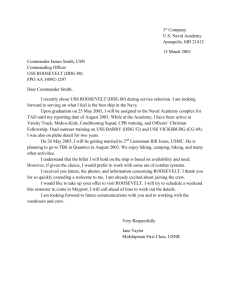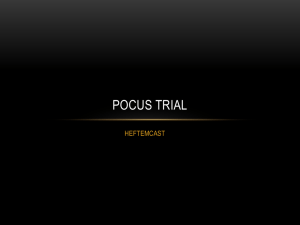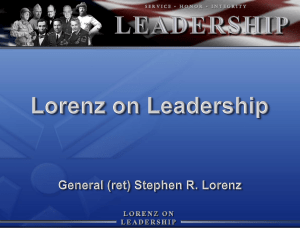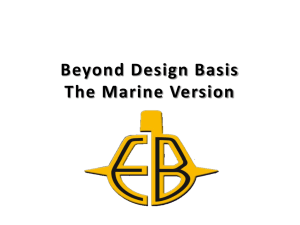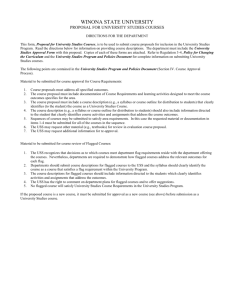Case Study Vincennes Incident
advertisement
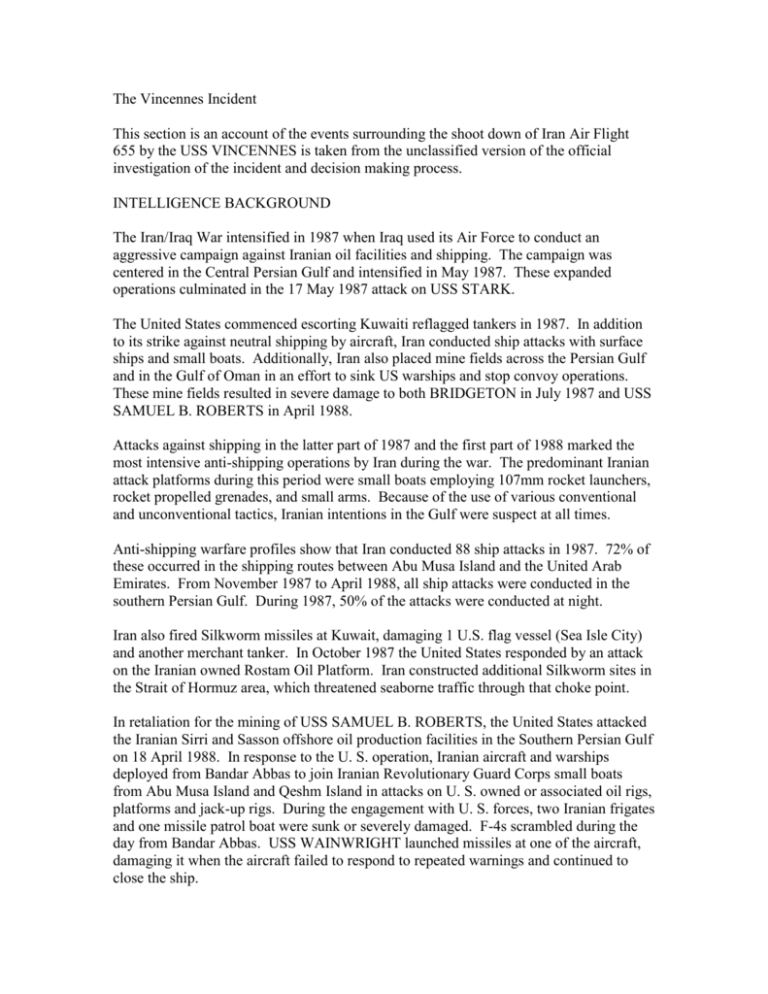
The Vincennes Incident This section is an account of the events surrounding the shoot down of Iran Air Flight 655 by the USS VINCENNES is taken from the unclassified version of the official investigation of the incident and decision making process. INTELLIGENCE BACKGROUND The Iran/Iraq War intensified in 1987 when Iraq used its Air Force to conduct an aggressive campaign against Iranian oil facilities and shipping. The campaign was centered in the Central Persian Gulf and intensified in May 1987. These expanded operations culminated in the 17 May 1987 attack on USS STARK. The United States commenced escorting Kuwaiti reflagged tankers in 1987. In addition to its strike against neutral shipping by aircraft, Iran conducted ship attacks with surface ships and small boats. Additionally, Iran also placed mine fields across the Persian Gulf and in the Gulf of Oman in an effort to sink US warships and stop convoy operations. These mine fields resulted in severe damage to both BRIDGETON in July 1987 and USS SAMUEL B. ROBERTS in April 1988. Attacks against shipping in the latter part of 1987 and the first part of 1988 marked the most intensive anti-shipping operations by Iran during the war. The predominant Iranian attack platforms during this period were small boats employing 107mm rocket launchers, rocket propelled grenades, and small arms. Because of the use of various conventional and unconventional tactics, Iranian intentions in the Gulf were suspect at all times. Anti-shipping warfare profiles show that Iran conducted 88 ship attacks in 1987. 72% of these occurred in the shipping routes between Abu Musa Island and the United Arab Emirates. From November 1987 to April 1988, all ship attacks were conducted in the southern Persian Gulf. During 1987, 50% of the attacks were conducted at night. Iran also fired Silkworm missiles at Kuwait, damaging 1 U.S. flag vessel (Sea Isle City) and another merchant tanker. In October 1987 the United States responded by an attack on the Iranian owned Rostam Oil Platform. Iran constructed additional Silkworm sites in the Strait of Hormuz area, which threatened seaborne traffic through that choke point. In retaliation for the mining of USS SAMUEL B. ROBERTS, the United States attacked the Iranian Sirri and Sasson offshore oil production facilities in the Southern Persian Gulf on 18 April 1988. In response to the U. S. operation, Iranian aircraft and warships deployed from Bandar Abbas to join Iranian Revolutionary Guard Corps small boats from Abu Musa Island and Qeshm Island in attacks on U. S. owned or associated oil rigs, platforms and jack-up rigs. During the engagement with U. S. forces, two Iranian frigates and one missile patrol boat were sunk or severely damaged. F-4s scrambled during the day from Bandar Abbas. USS WAINWRIGHT launched missiles at one of the aircraft, damaging it when the aircraft failed to respond to repeated warnings and continued to close the ship. The Iranian Air Force and Iranian warships conducted a total of 187 attacks on shipping since the campaign began in March 1984; most of these attacks occurred prior to August 1986. Following August 1986, Iranian fighter aircraft were rarely used in the ship attacks in an apparent attempt to conserve platforms. The Iranians have Maverick missiles. Each missile can be launched from ranges of .5 to 13 NM and television guided. The launching aircraft must be able to keep visual track of the target but does not have to illuminate the target with radar. Although there has been no record of F-14s being used for iron bomb attacks, the aircraft is capable of being modified to be used in that role. To use iron bombs, the F-14 would have to close to within 2 NM of the target. That information was included in the intelligence information provided to USS VINCENNES on inchop. The most recent, confirmed Iranian Air Force anti-shipping attack was on 2 February 1988 when 2 Iranian F-4s launched Maverick missiles at the Liberian Tanker, PETROBULK PILOT, at 30 NM SSW of the point where USS VINCENNES launched its missiles on 3 July. Iranian Air Force operating patterns changed significantly, particularly at Bandar Abbas, in the month prior to 3 July 1988. Iranian F-14s have been observed to fly at airspeeds of between 250 knots while climbing to patrol station and 350-400 knots while on patrol. During air-to-air intercepts the F-14s have achieved speeds of 500-550 knots. The addition of the F-14s to the air order of battle at Bandar Abbas was perceived by CJTFME as an upgrade in Iranian air capability at Bandar Abbas. USS VINCENNES was advised by CJTFME on 18 June 1988 of the changing patterns of F-4's operating from Bandar Abbas; "All units are cautioned to be on the alert for more aggressive behavior..." USS VINCENNES was advised of the deployment of Iranian F14s to Bandar Abbas: "The F-14 deployment represents an increased threat to allied aircraft operating in the Strait of Hormuz, Southern Persian Gulf, and Gulf of Oman." In the week preceding the USS VINCENNES incident, the Iraqi Air Force stepped up its attacks on Iranian oil facilities and shuttle convoys in the Northern Persian Gulf. Iranian reaction to these successful Iraqi attacks was anticipated by CJTFME and they warned the Middle East Force, including USS VINCENNES on 2 July 1988. USS VINCENNES was apprised that Iranian reaction should be expected. "...in the meantime, anticipate IRGC ship attacks in retaliation for Iraqi Air Force attacks on Iranian shuttle tankers." At 021600Z the Danish ship, KARAMA MAERSK, outbound from Saudi Arabia, was repeatedly, though unsuccessfully, attacked by IRGC small boats at a point 20 NM southwest of Abu Musa Island. The KARAMA MAERSK issued a "mayday" requesting assistance and USS ELMER MONTGOMERY responded and observed several IRGC small boats fire three rockets at the Danish merchant at 1630Z. The IRGC boats included at least one Boghammer and two machine-gun equipped Boston Whalers. The USS ELMER MONTGOMERY fired a warning shot at the small boats at about 1730Z and the boats retired to the northwest. RULES OF ENGAGEMENT USS VINCENNES had onboard a current copy of the effective ROE for the Persian Gulf. The primary responsibility of the Commanding Officer under the ROE is the defense of his ship from attack or from threat of imminent attack. As a result of the attack on the USS STARK, the JCS issued an updated Notice to Airman for the Persian Gulf, Strait of Hormuz, Gulf of Oman and North Arabian Sea dated 8 September 1987, which notified all Persian Gulf countries of additional defense precautions which U. S. warships would be exercising. It highlighted the requirement for aircraft operating in the area to maintain a listening watch on 121.5 MHZ VHF or 234.0 MHZ UHF. Both the Department of State and ICAO reported that this Notice to Airmen was transmitted through channels to the Government of Iran. COMMERCIAL AIR A total of 18 commercial air routes cross the Persian Gulf area covering at least 50% of the navigable waters. A total of 12 commercial air routes cross the Southern Persian Gulf/Strait of Hormuz area alone. At least 1775 commercial air flights passed through Oman Center for the week ending 13 July 1988. The CJTFME inchop brief discusses commercial air traffic in general but does not focus on any specific air routes or COMAIR schedules. The brief also discusses the use of Military Air Distress and International Air Distress with the latter used to contact commercial aircraft and "unless you are up a regional ATC frequency, use IAD to try to contact ATC." The brief alludes to the "very complex but ordered" commercial air picture. It cautions all units to be concerned with those air contacts, which deviate from the normal pattern. The first time the CJTFME promulgated commercial airline flight information to the ships in the Persian Gulf area was on 28 June 1988. This message showed Iranian Air Flight 655 scheduled to depart Bandar Abbas at 0920Z on Tuesday and Sunday of each week. On Sunday, 3 July 1988, there were 10 civilian flights scheduled from Bandar Abbas. There were 150 challenges issued for the period of 2 June 1988 to 2 July 1988. Only two of those challenges were commercial aircraft. 125 challenges were to Iranian military aircraft. From 13 June 1988 to 2 July 1988 seven Iranian F-14s were issued challenges. INCIDENT INTRODUCTION On 3 July 1988, the USS VINCENNES (CG 49), operating in the Southern Persian Gulf as a unit assigned to Commander, Joint Task Force Middle East, downed a civilian airliner, Iran Air Flight 655 on a routine scheduled flight from Bandar Abbas to Dubai, with two SM-2 missiles. The material condition, combat systems, training and personnel readiness of the ship were found to be satisfactory. The following narrative summarizes the events leading up to and including the downing of Iran Air Flight 655. It is in the form of a chronology because the situation leading up to, just prior to, and during the few critical minutes from Iran Air Flight 655 takeoff to downing are considered important to a full understanding of the incident. All times in this summary are "Z" time. PRE-3 JULY SCENARIO In the three-day period prior to the incident, there was heightened air and naval activity in the Persian Gulf. Iraq conducted air strikes against Iranian oil facilities and shipping 30 June through 2 July 1988. Iranian response was to step up ship attacks. Additionally, Iran deployed F-14s from Bushehr to Bandar Abbas. U. S. Forces in the Persian Gulf were alerted to the probability of significant Iranian military activity resulting from Iranian retaliation for recent Iraqi military successes. That period covered the fourth of July holiday weekend. During the afternoon and evening hours of 2 July 1988 and continuing into the morning of 3 July 1988, Iranian Revolutionary Guard Corps (IRGC) armed small boats (Boghammers, and Boston Whalers) positioned themselves at the western approach to the Strait of Hormuz (SOH). From this position, they were challenging merchant vessels, which has been a precursor to merchant ship attacks. On 2 July 1988, USS ELMER MONTGOMERY (FF 1082) was located sufficiently close to a ship attack in progress as to respond to a request for distress assistance and to fire warning shots to ward off IRGC small boats attacking a merchant vessel. 3 JULY SURFACE ENGAGEMENT On the morning of 3 July 1988, USS ELMER MONTGOMERY was on patrol in the northern portion of the Strait of Hormuz. At approximately 0330Z, USS ELMER MONTGOMERY observed seven small Iranian gunboats approaching a Pakistani merchant vessel. The small boats were reported by USS ELMER MONTGOMERY to have manned machine gun mounts and rocket launchers. Shortly thereafter, USS ELMER MONTGOMERY observed a total of 13 Iranian gunboats breaking up into three groups. Each group contained 3 to 4 gunboats with one group of four gunboats taking position off USS ELMER MONTGOMERY's port quarter. At 0411Z, USS ELMER MONTGOMERY heard the gunboats over bridge-to-bridge radio challenging merchant ships in the area. USS ELMER MONTGOMERY then heard 5 to 7 explosions coming from the north. At 0412Z, "Golf Sierra" directed USS VINCENNES to proceed north to the vicinity of USS ELMER MONTGOMERY and investigate USS ELMER MONTGOMERY's report of small boats preparing to attack a merchant ship. USS VINCENNES' helo (OCEAN LORD 25/Lamps Mk-III helo) on routine morning patrol was vectored north to observe the Iranian small boat activity. USS VINCENNES was also monitoring a routine maritime patrol of an Iranian P-3 operating to the west. At approximately 0615Z, the USS VINCENNES' helicopter was fired upon by one of the small boats. USS VINCENNES then took tactical command of USS ELMER MONTGOMERY and both ships proceeded to close the position of the helicopter and the small boats at high speed. As USS VINCENNES and USS ELMER MONTGOMERY approached the position of the small boats, two of them were observed to turn towards USS VINCENNES and USS ELMER MONTGOMERY. The closing action was interpreted as a demonstration of hostile intent. USS VINCENNES then requested and was given permission by CJTFME to engage the small boats with gunfire. At approximately 0643Z, USS VINCENNES opened fire and was actively involved in the surface engagement from the time Iranian Air Flight 655 took off from Bandar Abbas through the downing of Iran Air Flight 655. During the course of the gun engagement of the Iranian small boats, the USS VINCENNES, at approximately 0654Z, had maneuvered into a position one mile west of the centerline of civilian airway Amber 59. The USS SIDES (FFG 14), transiting from east to west through the SOH, was approximately 18 miles to the east and became involved in the evolving tactical situation. BANDAR ABBAS/IRAN AIR FLIGHT 655/AIR ENGAGEMENT On 3 July 1988, at approximately 0647Z, an Iran Air Airbus 300, Iran Air Flight 655, took off from the Bandar Abbas joint military/civilian airport destined for Dubai airport. The flight was a routine scheduled, international flight via commercial airway Amber 59. An Iranian military aircraft took off approximately 7 minutes after Iran Air Flight 655, and a number of Iranian F-4's were observed to be operating in the area of Bandar Abbas approximately 30 minutes after the incident. Iran Air Flight 655 took off on runway 21, was directed by the Bandar Abbas Tower to squawk IFF mode III code 6760, and began a normal climb out to assigned altitude of 14,000 feet for the flight, which lasted a total of 7 minutes before the plane was hit by the missiles from USS VINCENNES. The pilot remained within the Amber 59 air corridor (20 miles wide, 10 miles each side of centerline), made a routine position report to Bandar Abbas departure control at approximately 0654Z, and was ascending through 12,000 feet at a speed of approximately 380 KTS at the time of making his report. At approximately 0654Z, the missiles fired from USS VINCENNES impacted the aircraft at an altitude of 13,500 feet, approximately 8 miles from USS VINCENNES, with Iran Air Flight 655 still in its assigned air corridor. Debris from the aircraft and a significant number of bodies were found 6.5 miles east of Hengham Island. While no passenger manifest or list of deceased has been released by Iran, various sources have established that some 290 persons from six nations were on board Iran Air Flight 655. At approximately 0647Z, Iran Air Flight 655 was detected by the USS VINCENNES' AN/SPY-1A radar bearing 025 degrees, 47 NM, and was assigned track number 4131. At approximately 0648Z, USS SIDES detected Iran Air Flight 655; bearing approximately 355 degrees, range approximately 32 miles. The aircraft continued to close USS VINCENNES with a constant bearing, decreasing range. At approximately 0649Z, USS VINCENNES issued warnings on Military Air Distress (MAD) and at 0650Z began warnings on International Air Distress (IAD) to TN 4131 located 025 degrees, 40 NM from USS VINCENNES. At approximately 0650Z, several USS VINCENNES CIC personnel heard, on internal Combat Information Center voice circuits, a report of F-14 activity. A momentary Mode II 1100 IFF indication was detected which was correlated with an Iranian F-14. This was reported throughout CIC over internal CIC voice circuits. Continuous MAD and IAD warnings were ordered at 30 NM (5 warnings on MAD and 4 total warnings on IAD). USS VINCENNES continued the surface engagement and experienced a foul bore in Mount 51. In order to unmask the after gun mount, full rudder (at 30 knots) was applied. This added to the increasing tension in CIC. At approximately 0652Z, warnings continued over both IAD and MAD. Still there was no response. Although TN 4131 reached the 20 NM point, the CO decided not to engage. The order was given to illuminate the contact with fire control radar. There were no ESM indications. TN 4131 was ascending through 10,000 feet. At approximately 0653Z, at 15-16 NM, USS SIDES gave the last warning over IAD to the aircraft bearing 204 degrees to USS VINCENNES, range 15.5 miles. During the last 30 seconds of this minute, the CO made his decision to engage TN 4131. At approximately 0654Z, the CO turned the firing key. Two SM-2 missiles left the rails. They intercepted Iran Air Flight 655 at a range of 8 NM from USS VINCENNES at an altitude of 13,500 feet. POST-INCIDENT INVESTIGATION The focus of this investigation was on the key factors that figured in determination of what information was available to the Commanding Officer upon which to base his decision to engage TN 4131, the validity of that data, and what other factors entered into his decision making process. Essential to this determination was a detailed examination of the USS VINCENNES' data reduction tapes, which portray second-by-second the position, kinematics, IFF information and Link 11 message flow of all contacts held by the USS VINCENNES' AEGIS Weapon System. The data extracted depicted the Iran Air Flight 655 flight profile from first detection to missile intercept. Further, the data allow reconstruction of all "button actions" by Command and Decision (C&D) console operators in CIC and the information available to them on their console readouts. Crucial to the investigation became close examination of the approximately 3 minute 45 second period just prior to the Commanding Officer's final decision to fire. During this period, verbal reports were being made by one of the console operators over internal circuits of decreasing range and altitude. Additionally, the fact that the range of TN 4131 in this period was rapidly approaching the final weapons release point for the incoming aircraft factors into the decision to fire. Also crucial to the investigation was the explanation (where possible) of the divergence between the data available in the AEGIS system derived from the data reduction tapes and the reports received by the CO and "GW" (the CO's principal air war advisor), especially the reports of "F-14", "IFF", and "decreasing altitude". The data from USS VINCENNES' tapes, information from USS SIDES and reliable intelligence information, corroborate the fact that TN 4131 was on a normal commercial air flight plan profile, in the assigned airway, squawking Mode III 6760, on a continuous ascent in altitude from takeoff at Bandar Abbas to shoot down. DECISION INDICATORS AS STATED BY CO USS VINCENNES * F-14s had been recently moved to Bandar Abbas. * Iranian fighters had flown coincident with surface engagement on 18 April 1988. * The aircraft was not responding to verbal warnings over IAD or MAD. * There had been warnings of an increased threat over the July 4th weekend. * Increased hostile activity had been predicted for the 48 hours following recent Iraqi military victory. * The aircraft was not following the air corridor in the same manner as other commercial aircraft had been seen consistently to behave (i.e., flying exactly on the centerline). * It was flying at a reported altitude, which was lower than commercial aircraft were observed to fly in the past. * TN 4131 was reported to be increasing in speed and decreasing in altitude. * TN 4131 was on a constant bearing, decreasing range to USS VINCENNES and USS ELMER MONTGOMERY. * TN 4131 was reported by USS VINCENNES' personnel squawking Mode II 1100, which correlates with an F-14. * No ESM was reflected from TN 4131, however, F-14s can fly "cold nose" (no emitters). * F-14s have an air-to-surface capability with Maverick and modified Eagle missiles. * The aircraft appeared to be maneuvering into an attack position. * Visual identification of the aircraft was not feasible. INVESTIGATION CONCLUSIONS Time compression played a significant role in the incident. From the time the CO first became aware of TN 4131 as a possible threat, until he made his decision to engage, the elapsed time was approximately three minutes, forty seconds. Additionally, the Commanding Officer's attention that was devoted to the ongoing surface engagement against IRGC forces left very little time for him to personally verify information provided to him by his CIC team in which he had great confidence. The fog of war and those human elements that affect each individual differently - not the least of which was the thought of the STARK incident - are factors that must be considered. As the investigation developed, and it was discovered that there were disparities between the C&D tape data and what various members of CIC believed they saw, the senior investigating officer requested the professional advice of USN Medical Corps personnel who have studied combat stress. The following opinions draw heavily on their conclusions. Stress, task fixation, and unconscious distortion of data may have played a major role in this incident. TIC and IDS (CIC watchstanders) became convinced TN 4131 was an Iranian F-14 after receiving the IDS report of a momentary Mode II. After this report of the Mode II, TIC appears to have distorted data flow in an unconscious attempt to make available evidence fit a preconceived scenario. TIC's perception that there was an inexperienced, weak leader in the AAWC position led to the emergence of TIC in a leadership role. TIC's reports were accepted by all and could have influenced the final decision to launch missiles. The violent maneuvers of the ship, the noise of the guns firing, gear falling in CIC and the lights in the LSD's flickering, heightened the tension in CIC during the critical time TN 4131 was being evaluated.
